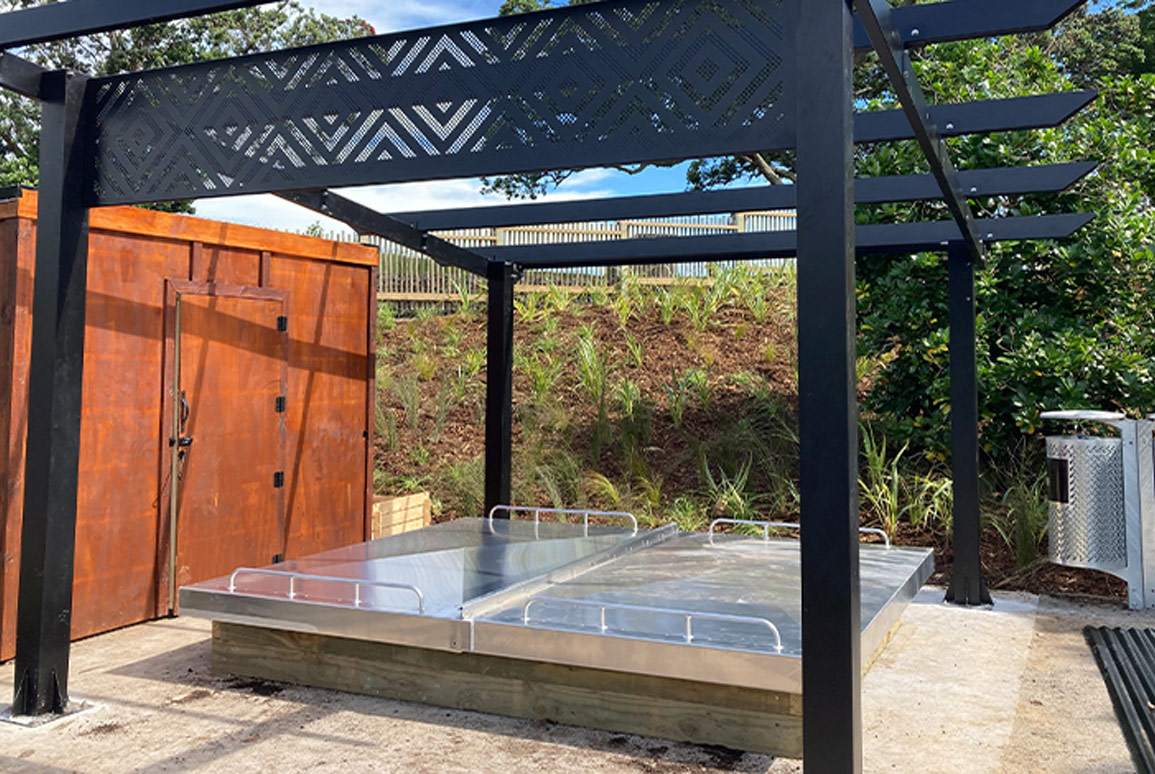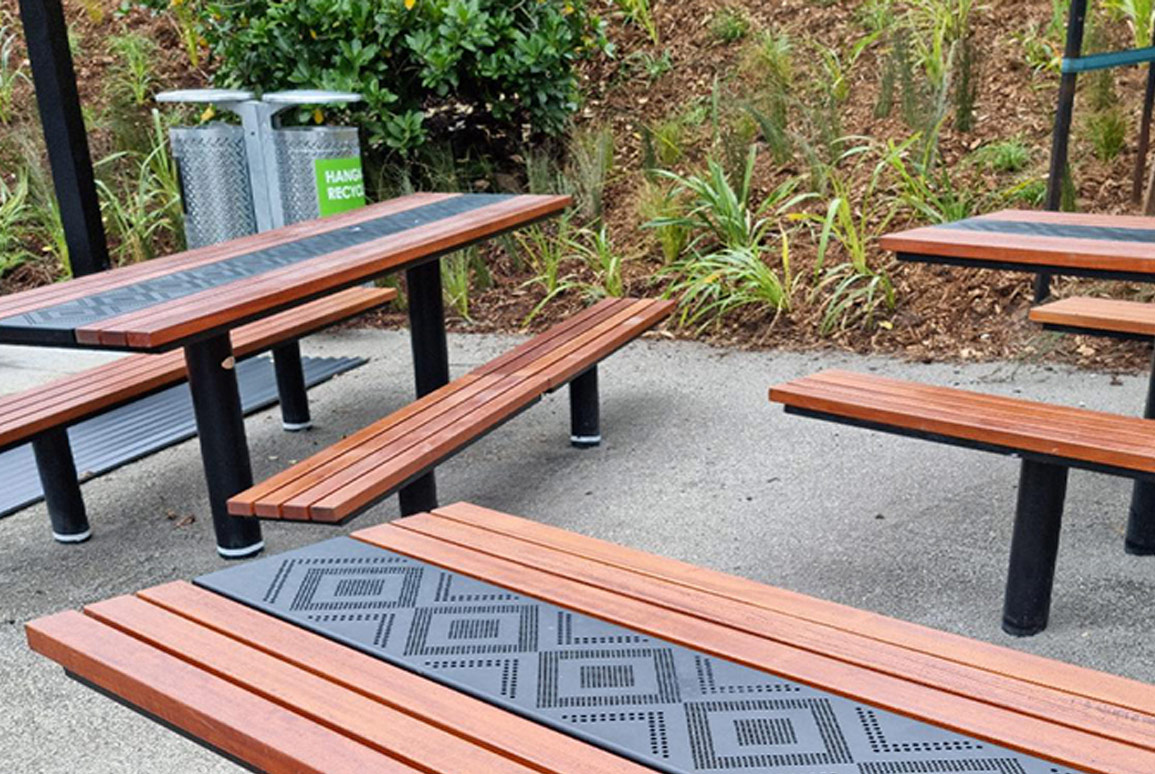Making Hāngī a reality in parks and open spaces – Whānau Ātea, Te Pane a Mataoho
20 December 2022
The long-anticipated Whānau Ātea, which redefines what a papa tākaro looks like in 21st-century Aotearoa, includes an innovative hāngi and kai space.

The long-anticipated Whānau Ātea, which redefines what a papa tākaro looks like in 21st-century Aotearoa, includes an innovative hāngi and kai space.
For centuries, Te Pane a Mataoho (Māngere Maunga) has been home to many whānau and hapori (community) who’ve lived, worked and played on this wāhi taonga (treasured place).
An important part of Māori life was the transference of knowledge and traditional practices which were prevalent on Ngā Tūpuna Maunga (ancestral mountains). Hāngī is one of these important traditions; and was part of community life, sustaining people across time and generations. Hāngī were common across many spaces in the past. However, what once was lore, in recent times, has been challenged by law.
Hāngī are important features of many marae and wāhi whakahirahira (significant cultural places) across Aotearoa. They are our own unique and long-standing way of coming together and celebrating around kai. There have been no hāngī implemented in public spaces due to many restrictions, and health and safety issues. However, in 2019, the Tūpuna Maunga Authority saw the opportunity to see whether practices like hāngī can be designed safely and implemented in a way that respects tradition, the community and the environment. The long-anticipated Whānau Ātea, which redefines what a papa tākaro looks like in 21st-century Aotearoa, has incorporated an innovative hāngi and kai space.
The Tūpuna Maunga Authority Chair, Paul Majurey, states that “the Authority worked to promote an enduring relationship between the maunga and the wider community, and envisaged a place of gathering, recreating, and sharing pūrākau; and, importantly, kai.”
Landscape architect William Hatton shares a similar view expressing, “It’s been exciting to work with the Tūpuna Maunga Authority, kaitiaki, knowledge holders and many mātanga (experts) in bringing Whānau Ātea to reality. An exciting part has been working with many mātanga Māori, one of them being Hāngī Master Rewi Spraggon; whose knowledge and goal of bringing hāngī to the forefront of our unique Aotearoa cuisine provided the best-possible solution for public hāngī.”
The design team undertook extensive research, design-testing and problem-solving; collectively working with Rewi Spraggon to learn and understand the practices and processes of making hāngī and understanding the associated whakapapa in relation to Te Pane-a-Mataoho. Importantly, these learnings helped to ensure proper tikanga towards design and practical implementation. As Rewi puts it, “It’s part of my approach to retain tikanga of hāngī-making, as well as the fine traditions of kai and feeding those who most need it.”
The placement of the hāngī on site was carefully considered by the design team; informed by the playspaces, accessibility and the access and connection to services. The design of the hāngī pits are Rewi’s own creation which cater for up to 400-plus people at a time. The pits centralise the hāngī and kai space; but, to ensure a cohesive and well-functioning area, some changes were required to make the hāngī and its surrounds fit-for-purpose.
Landscape architect Aynsley Cisaria says, “The development of this innovative hāngī and kai space is a collective effort, bringing together traditional and contemporary knowledge from many. New methods to shelter, protect and ensure proper health and safety standards for hāngī were undertaken by a community of innovative and future-thinking people.”
EPS Fabrication took on the challenge to design and build a top-quality and high-standard hāngī cover that would be multifunctional, durable, long-lasting and ensure health, safety and security. They manufactured two unique hāngī covers that interlock above the hāngī pits and also allow for two preparation and serving tables (when turned upside down).

To ensure hāngī can be used safely all year round, a bespoke shelter manufactured by Tilley Group Ltd. provides protection and sheltering whilst incorporating mahi toi to demarcate the hāngī and kai area. To compliment this space, a bespoke suite of furniture was designed and developed, also incorporating mahi toi within the picnic tables, seating, benches and bins.
As contractors for Whānau Ātea, the team from HEB built the large hāngī shed to store and secure all necessary equipment and elements. The internal fitout was worked through closely with Rewi to cater to the needs of hāngī. As part of overall design, careful consideration was given to the surrounding planting. Hardy native plants were planted to filtre water and runoff from the hāngī whilst also providing for kai and use in hāngī – for example, puka leaves to wrap and cover kai.
Whānau Ātea has been an exciting and explorative approach to the way we think, design and reinterpret indigenous play and recreational spaces in Aotearoa. The collaboration while implementing hāngī has been one of the many highlights associated to Whānau Ātea retaining the local traditions.
Deputy Chair and Māngere-Ōtāhuhu ward councillor, Alf Filipaina says, “We are thrilled to make the Whānau Ātea available to the Māngere Bridge community. We anticipate the Whānau Ātea at Te Pane o Mataoho will fast become a destination for families across Tāmaki Makaurau.”
With the introduction of these new hāngī pits on Te Pane a Mataoho, it is hoped that more public parks and open spaces will provide traditions and tikanga as a way to come together and enjoy the past-times of gathering and celebrating around kai.
For further information please contact William Hatton, Aynsley Cisaria or Janine Bell.

